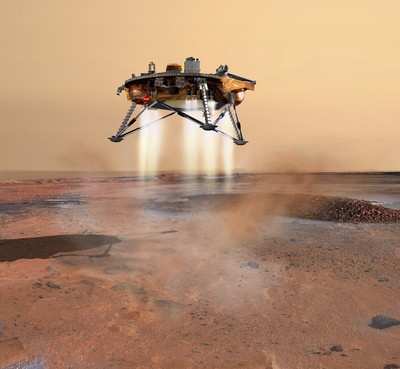Primary Mission Nears End, Second Phase To Begin Tuesday
The next sample of Martian soil being grabbed for analysis is
coming from a trench about three times deeper than any other trench
NASA's Phoenix Mars Lander has dug.

On Tuesday, the spacecraft will finish the 90 Martian days (or
"sols") originally planned as its primary mission and will continue
into a mission extension through September, as announced by NASA in
July.
Phoenix landed on May 25.
"As we near what we originally expected to be the full length of
the mission, we are all thrilled with how well the mission is
going," said Phoenix Project Manger Barry Goldstein of NASA's Jet
Propulsion Laboratory, Pasadena, CA.
 Phoenix's main task for Sol 90 is to scoop up a sample of soil
from the bottom of a trench called "Stone Soup," which is about 18
centimeters, or 7 inches deep. On a later sol, the lander's robotic
arm will sprinkle soil from the sample into the third cell of the
wet chemistry laboratory. This deck-mounted laboratory, part of
Phoenix's Microscopy, Electrochemistry and Conductivity Analyzer
(MECA), has previously used two of its four soil-testing cells.
Phoenix's main task for Sol 90 is to scoop up a sample of soil
from the bottom of a trench called "Stone Soup," which is about 18
centimeters, or 7 inches deep. On a later sol, the lander's robotic
arm will sprinkle soil from the sample into the third cell of the
wet chemistry laboratory. This deck-mounted laboratory, part of
Phoenix's Microscopy, Electrochemistry and Conductivity Analyzer
(MECA), has previously used two of its four soil-testing cells.
"In the first two cells we analyzed samples from the surface and
the ice interface, and the results look similar. Our objective for
Cell 3 is to use it as an exploratory cell to look at something
that might be different," said JPL's Michael Hecht, lead scientist
for MECA. "The appeal of Stone Soup is that this deep area may
collect and concentrate different kinds of materials."
Stone Soup lies on the borderline, or natural trough, between
two of the low, polygon-shaped hummocks that characterize the
arctic plain where Phoenix landed. The trench is toward the left,
or west, end of the robotic arm's work area on the north side of
the lander.
When digging near a polygon center, Phoenix has hit a layer of
icy soil, as hard as concrete, about 5 centimeters, or 2 inches,
beneath the ground surface. In the Stone Soup trench at a polygon
margin, the digging has not yet hit an icy layer like that.
"The trough between polygons is sort of a trap where things can
accumulate," Hecht said. "Over a long timescale, there may even be
circulation of material sinking at the margins and rising at the
center."
The science team had considered two finalist sites as sources
for the next sample to be delivered to the wet chemistry lab. This
past weekend, Stone Soup won out. "We had a shootout between Stone
Soup and white stuff in a trench called 'Upper Cupboard,'" Hecht
said. "If we had been able to confirm that the white material was a
salt-rich deposit, we would have analyzed that, but we were unable
to confirm that with various methods."
Both candidates for the sampling location offered a chance to
gain more information about salt distribution in the Phoenix work
area, which could be an indicator of whether or not liquid water
has been present. Salt would concentrate in places that may have
been wet.
While proceeding toward delivery of a sample from Stone Soup
into the wet chemistry laboratory, Phoenix is also using its
Thermal and Evolved-Gas Analyzer to examine a soil sample collected
last week from another trench, at a depth intermediate between the
surface and the hard, icy layer.

The Phoenix mission is led by Peter Smith from the University of
Arizona with project management at the Jet Propulsion Laboratory,
Pasadena, CA and development partnership at Lockheed Martin,
Denver. International contributions come from the Canadian Space
Agency; the University of Neuchatel, Switzerland; the universities
of Copenhagen and Aarhus in Denmark; the Max Planck Institute in
Germany; and the Finnish Meteorological Institute. The California
Institute of Technology in Pasadena manages JPL for NASA.
 ANN's Daily Aero-Linx (04.15.24)
ANN's Daily Aero-Linx (04.15.24) Classic Aero-TV: 'No Other Options' -- The Israeli Air Force's Danny Shapira
Classic Aero-TV: 'No Other Options' -- The Israeli Air Force's Danny Shapira Aero-News: Quote of the Day (04.15.24)
Aero-News: Quote of the Day (04.15.24) Airborne 04.16.24: RV Update, Affordable Flying Expo, Diamond Lil
Airborne 04.16.24: RV Update, Affordable Flying Expo, Diamond Lil ANN's Daily Aero-Term (04.16.24): Chart Supplement US
ANN's Daily Aero-Term (04.16.24): Chart Supplement US





